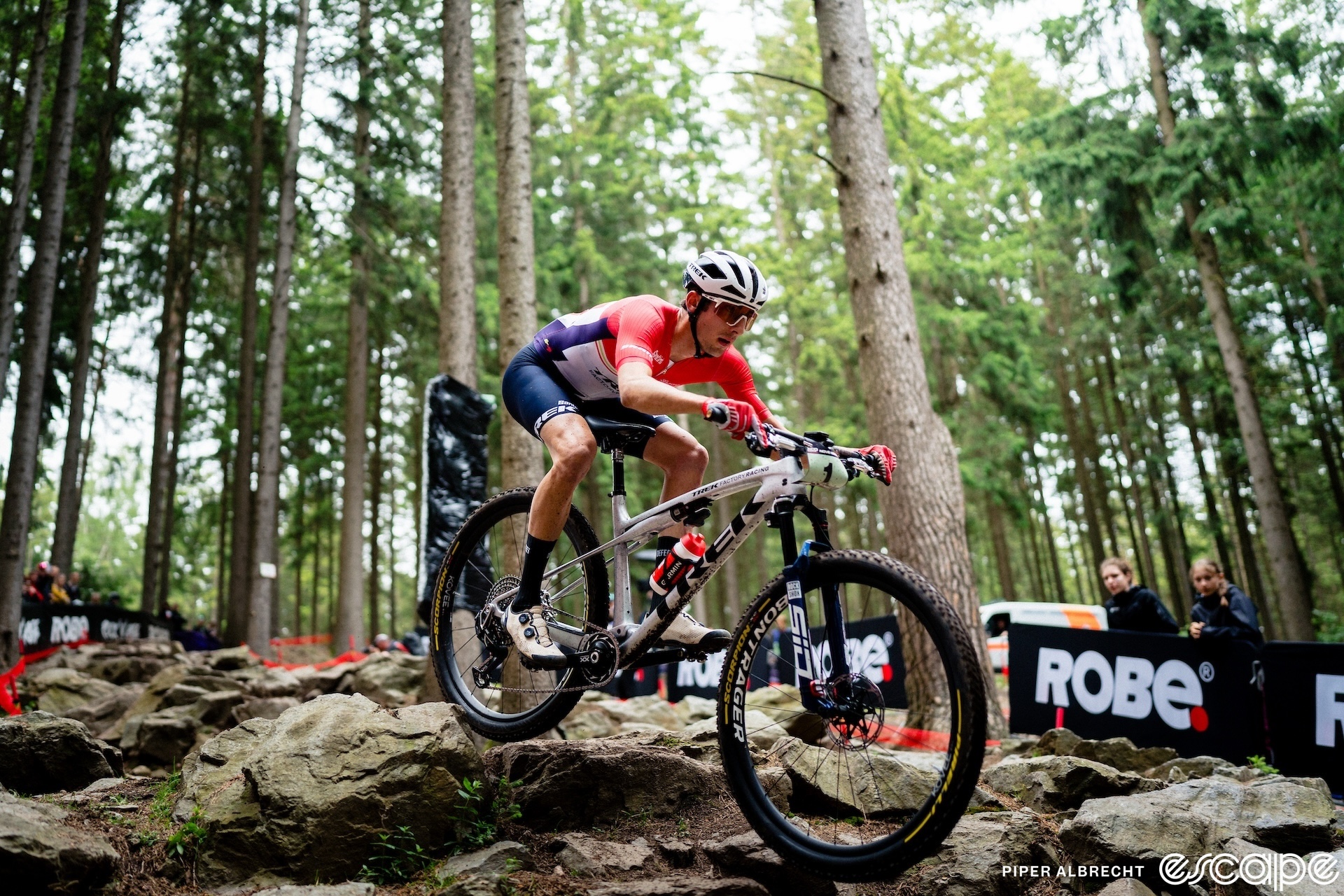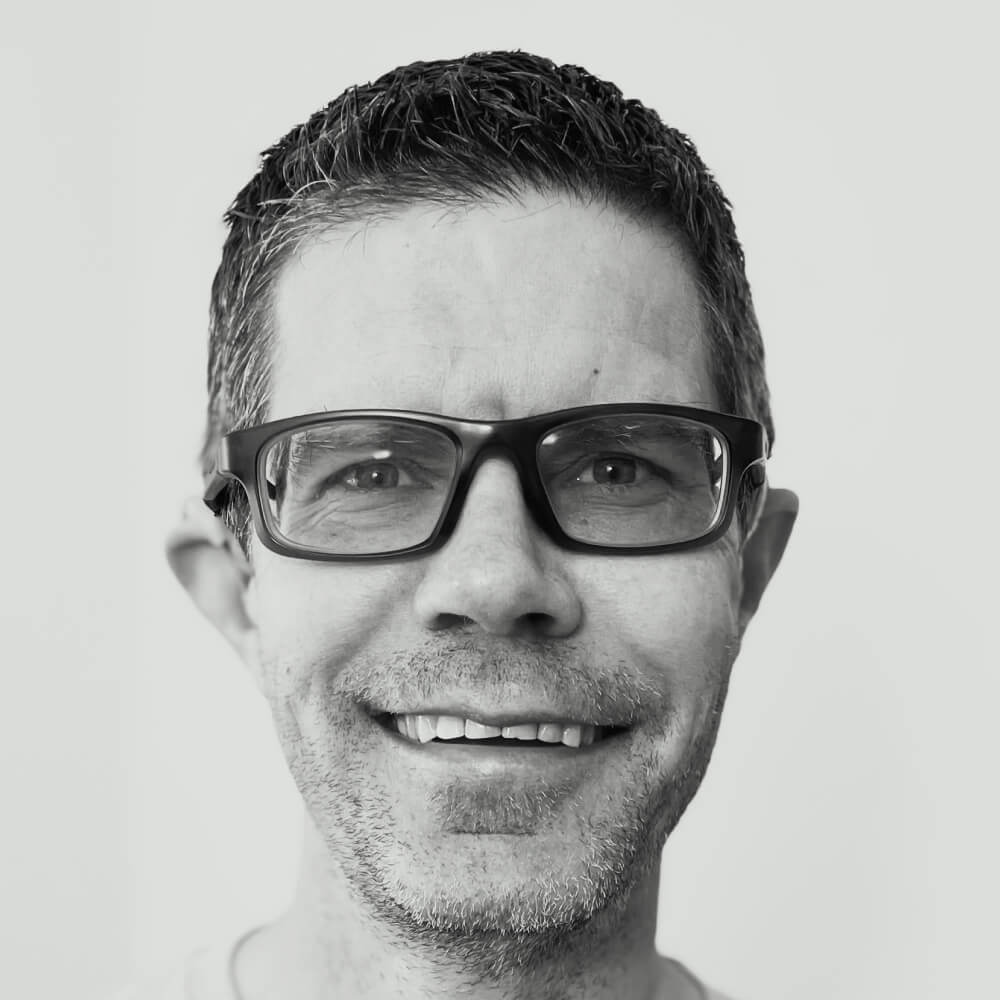Riley Amos is used to showing up and winning.
He did it at his first national-level race as a junior. He did it at just his third World Cup, when in his first season at the U23 level he became the youngest male World Cup winner ever – the first of a run of results that makes him one of the most promising young American mountain bike talents in years.
Now, Amos is in Paris, where he’ll be among the youngest riders in the men’s XCO field at the Olympic Games. Despite mountain biking’s rich history in the United States, the sport has been on some hard times there in recent decades. But Amos is part of a strong Olympic squad that features three medal contenders in Savilia Blunk, Haley Batten and Chris Blevins, all of whom have won or podiumed at elite World Cups in the last year.
Realistically, Amos is fourth of four in that pecking order. And there’s no pressure on him; at just 22 years old, he has time to mature and an eye on a home Games in Los Angeles in 2028. But that doesn’t mean he’s just here to have fun or even to gain Olympic experience. As always, when Riley Amos toes the start line, he’s there to race.
Amos is in Paris because – self-evidently – he’s very good at high-speed off-road bicycle cycling. But he’s also here because he’s from Durango. “The community itself here is what planted that seed for me,” he told Escape Collective in a long interview shortly before he left for Paris.
Neither of his parents, Rosaleen and Charlie, were really mountain bikers or, as their son sees it, big sports fans at all. “I mountain biked as a kid in the desert,” Charlie told Escape, “but I never raced.” But he did also sometimes ride on family trips to Durango to hunt and fish. The beauty of the Four Corners region, with its high desert chaparral tucked against the rugged San Juan mountains, always stuck with him.
Both Rosaleen and Charlie are originally from Tucson, Arizona, and after following Rosaleen’s work (she’s a contracts attorney) around the country for a bit, she found she could work remotely and the couple promptly high-tailed it for Durango as soon as Charlie could get in with the Durango Fire Department, where he’s now a captain. When their children, Riley and Braden (four years younger) were born, they promptly got both into all kinds of activities. “We were real adamant about putting Riley into everything possible when he was little,” said Rosaleen. “All the traditional sports, but also kayak and lacrosse, and music and everything else.”
Of course, if you live in Durango, mountain biking is a bit more than an “everything else” activity, and if you’re a kid in Durango, the place to be is the Durango Devo development program. Riley started in second grade, instantly recognizable in team photos as the kid in the full-face helmet. (“That was our choice at first,” said Rosaleen. “We wanted our kids to ski and bike in full-face, but when we asked him if he wanted a regular helmet, at first he said, ‘Oh, I’m good.’ He preferred it for a little while.”)
But if Devo is a legendary development program that has produced the likes of top XC racers like Blevins and Howard Grotts, not to mention Vuelta a España winner Sepp Kuss, it’s not remotely a hardcore racing factory. Co-founders Sarah Tescher and Chad Cheeney have always kept a firm focus on fun, and that aligned perfectly with the Amos family’s approach.
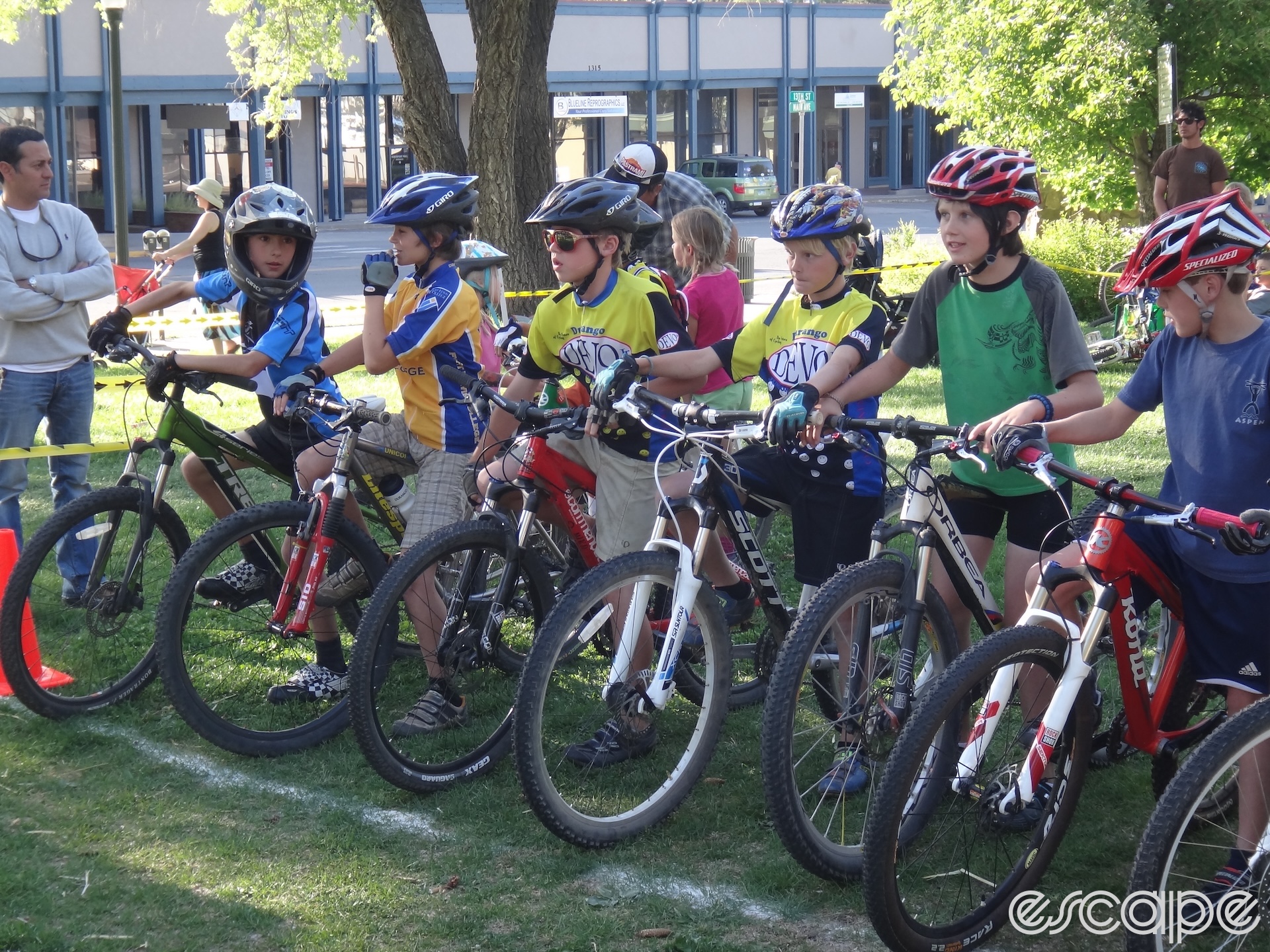
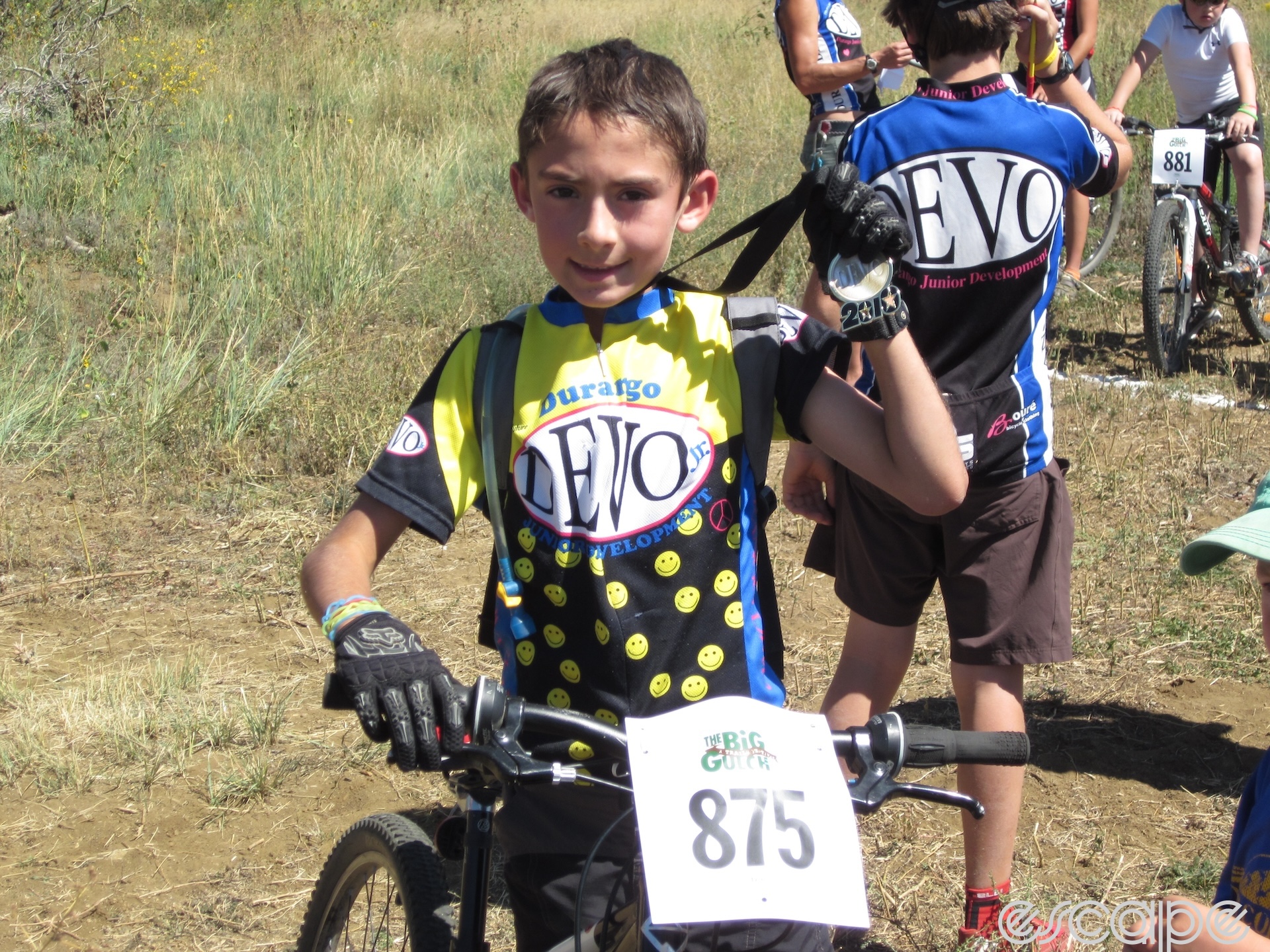
“We’d go on a ride and go explore a cave or jump in the river,” Amos said. “Some of my fondest memories growing up were as a 12- or 13-year-old, we’d go bikepacking for three days at the end of the season, a group of kids just loaded down with 80-pound bikes going into the Dolores River Basin.” But just as much as fun, he added, Devo taught him the value of work, and personal growth.
“We definitely felt like we wanted to protect him, in the sense that we never got serious,” said Charlie. His son was fast on a bike almost from the start, he added, but “we always reminded him that this is just a bike; it’s just bike racing. Our goal was never to build an Olympic athlete.”
Aside from informal Devo events, Amos didn’t even do his first race until he was 14. His freshman year of high school, he got heavily into racing on one of Durango’s two National Interscholastic Cycling Association (NICA) teams, often coming in second or third in deep, competitive Colorado fields.
As he got more serious, he and Rosaleen traveled to Snowshoe, West Virginia the next year for his first nationals. Although he’d started working with multi-time former national mountain bike and cyclocross champion Todd Wells as a coach, Amos had done little structured training and a relaxed approach to preparation. Speaking about a previous race in Soldier Hollow, Utah, he said with a laugh, “I had absolutely no clue what I was getting into; I had Domino’s pizza the night before the race.” Speaking of food, as of that nationals he’d never taken a feed in a race. He had also never raced East Coast trails or even in the mud. (“I don’t know how he learned to ride the mud,” cracked Charlie. Even now, he said, “It scares the living tar out of us to watch it.”) That didn’t stop Amos from taking the win at Snowshoe, beating riders who’d focused on the sport from an early age and even had sponsors from the age of 10. But those sponsors started coming Amos’ way too.
Amos might have been fast on a bike, but he wasn’t gentle, recalled Charlie. “As NICA became very serious for him, probably junior, senior year he was riding lighter and lighter bikes. He would break multiple things a week. I was like, ‘Dude, we can’t maintain this.’ That’s when he started going out and advocating for himself.” Amos took it on himself to seek out sponsors, and there were none more pivotal for him than another highly regarded development team, Bear National, which also helped boost Bjorn Riley, another major young US men’s talent.
“Riley and Bjorn probably came up to me within a half hour of each other at nationals,” recalled Bear team director Julia Violich of her first encounter with Amos. “He’s very nervous and looking up at me because he’s so tiny, like, ‘Hi Julia, I’m Riley and I was wondering…’.” Violich is a force in the American development scene; not only does she run Bear, which has produced riders like Blunk, Violich has long been an integral part of the women’s road team Virginia Blue Ridge-Twenty24, which has been essential in developing the careers of riders like World Time Trial Champion Chloe Dygert and Jen Valente, Omnium gold medalist at the Tokyo Olympics.
Violich says she was immediately captivated by Amos’ personality. Even at their first meeting, she said, “he had a little sparkle in his eye; I had a good feeling about him.” The word “sparkle” comes up a lot in conversation with Violich, at least in reference to Amos. At one early team camp, she recalls, she left Amos and a few of the riders alone for one night and when she came back the next morning they had shaved their heads, bleached the stubble blond, and wore temporary tattoos. “He just brings the stoke and wants to share his fun and love of the bicycle,” she said. But he was understandably quite raw as a racer. “I think we provided structure for him,” she said, “saying, ‘OK, here’s when you can sparkle, and here’s when you need to focus.’”
Amos flourished in the environment. Violich said one of her guiding principles at Bear is to instill riders with a sense that the sport is bigger than they are, and they have a responsibility to help grow it. Amos, she said, came to that naturally, jumping at the opportunity to ride with entry-level riders at events, and even cutting a donation check to the team (which is run as a non-profit) after he signed his first pro contract with Trek.
But Bear also provided Amos with essential exposure and opportunities, like training camps and races against top-level competition, and experience on more technical tracks like those found at the World Cup level. And when the COVID-19 pandemic hit, it was Bear that gave him his first experiences at those races.
With the season largely shut down, Amos was home in Durango, working in a shop and doing those big adventure rides with friends that he loves. But there wasn’t much racing, so when the UCI announced a hurried, end-of-season World Cup at Nové Mesto in Czechia and World Championships at Leogang, Austria, Violich jumped at the chance to bring a team. Amos had raced the 2019 worlds in Canada, but this was his first experience in Europe. On rough, technical tracks against fields of 80 top juniors, Amos knocked out a fifth-place finish at Nové Mesto and was on track for a medal at worlds before a late crash knocked him down to fourth.

But the die was cast. That next spring, he returned, riding in the U23 ranks on a short-term guest deal that Violich put together between Bear and the Trek Factory team, and promptly jumped to second on the Nové Mesto course before notching a win on the Leogang track. In just his third-ever U23 World Cup he became the sport’s youngest male winner at that level, and Trek was extremely pleased with its talented prodigy. “I remember sitting in my hotel room that night, knowing how different my life was going to be from there on out, with the opportunity I’d just given myself,” he recalled. Just 19 years old, Riley Amos had arrived. Little did he know it would be two long years before he set foot atop a podium again.
Amos’ 2022 season started off promising, with a fourth-place finish at the opening World Cup round in Brazil. And over the course of that year and into 2023, he notched a few podiums, and won several smaller races. But World Cup wins remained elusive.
“I had won a World Cup. So I set the bar for myself as high as it could be, and every race from there on out, anything less than a podium wasn’t a great race,” he said. “From lap one, I was racing all-out for the front because I kind of believed at that point that I could win every time. I was just still in the junior mentality of ‘Open the throttle all the way and race it full-gas.’”
Initially, he responded to his struggles by just doing what he’d always done: go harder. The result was things got worse; while he performed OK in short track, on XCO courses like Nové Mesto and Leogang where he’d previously duked it out for the win, he was now finishing in the 20s and 30s as a result of mechanicals, crashes, and other mishaps, some of them self-inflicted. “To some degree it was bad luck, but if you’re just pushing way too hard on descents, taking shitty lines, not knowing correct tire pressure and bike setup, then all those things contribute to those mechanicals,” he said with characteristic reflection.
A side effect of Amos’ quick rise was he was now a marked rider, and in a U23 field that included racers such as Martin Vidaurre, Carter Woods, and Charlie Aldridge, that kind of all-gas, no-tactics racing just didn’t work anymore.
“Any athlete at the highest level of the sport holds the bar really, really high,” observed Violich. “And when things aren’t going right, they start questioning everything: their training, their technical skills, their ability to recover well. And when you start questioning yourself, it’s very difficult to succeed.”
“He’s hard on himself, harder than anybody else,” said Rosaleen, noting that her son has always been driven and analytical. He was highly aware of not disappointing his team, she added, “very focused on making sure that he’s earning his spot, because he knows there are so many people working for him.” But even in the low points, she said, Amos never got too frustrated. His physical talents hadn’t dulled, but it was time to put his mental ones to use as well. It was time for a reset.
“I had to reinvent my process and go from being a really good junior to a smart, competitive, patient under-23,” he said. In that field, there are a handful of riders who can win any day on any course. Winning, he came to realize, was about being the rider who could get the best result out of the least effort.
Key to that, Amos said, was the support from Trek Factory. He stopped pushing so hard; instead he sat back and watched and listened, soaking up knowledge from experienced teammates like Olympic gold medalist Jolanda Neff and Anton Cooper. “People in my team really helped reframe my mentality around racing,” Amos said. “Like ‘Riley, you don’t have to be leading the race in the first lap. You just have to have contact with that front group.’”
But as much as anything, Amos also needed to reconnect with his love for riding. Back in the pandemic, Amos spent a bunch of time with other talented U23 riders like Bjorn Riley, Brayden Johnson, and Nolan Jenkins. “We just had a ton of fun, because we just truly loved riding and racing mountain bikes,” he said. “Instead of training necessarily, we became really good riders because we were always pushing each other,” railing descents, boosting airs and generally just having a blast. Getting back to that was key. Amos doesn’t have a European base, but on an extended stay in Andorra last year, he packed his fly rod in a handlebar bag and stopped during training rides to fish in high-mountain lakes.
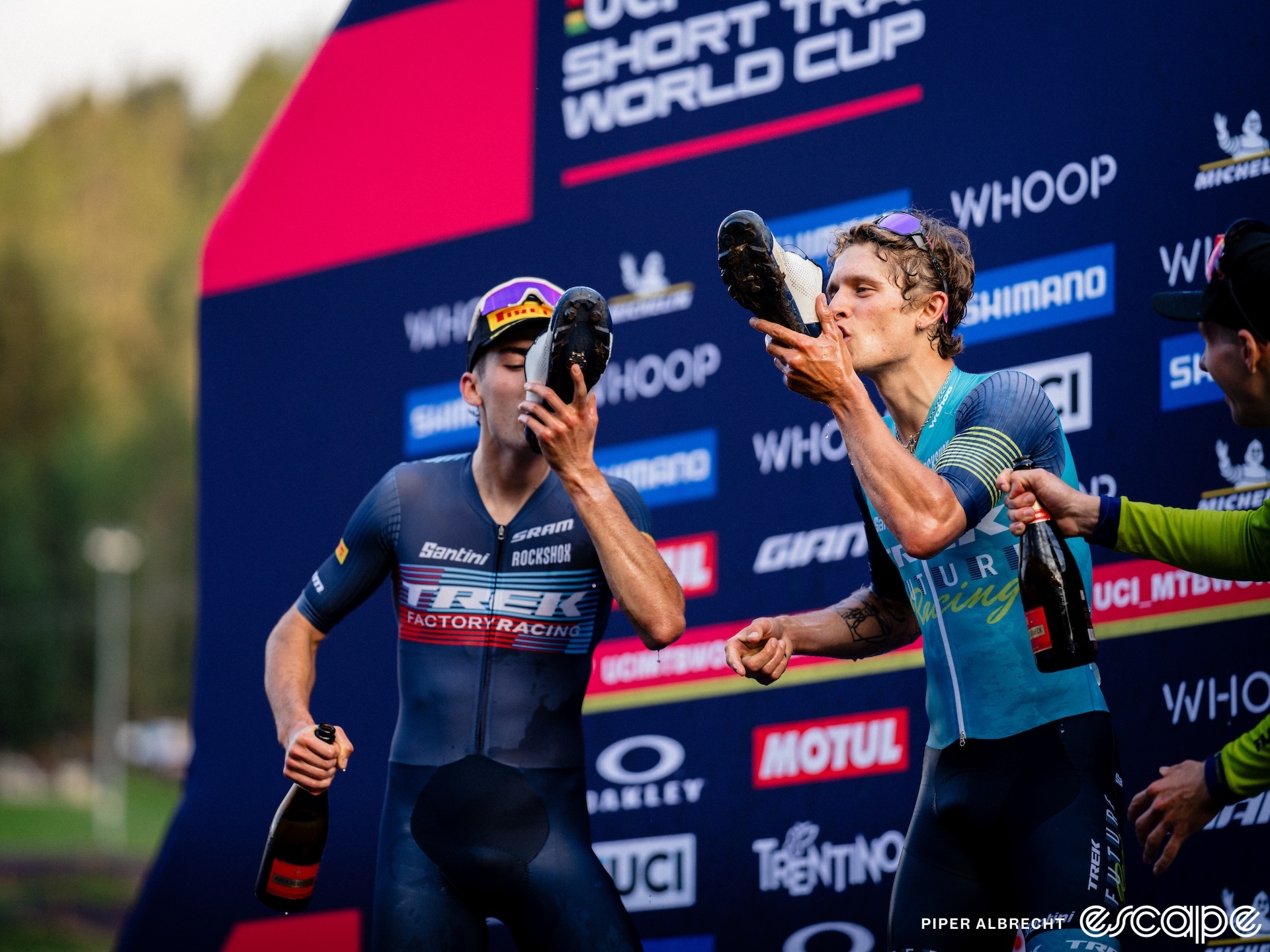
At Val di Sole in late June 2023, he turned the corner with a third place in the XCO. A fourth at August’s “Super” World Championships followed and then, finally, the breakthrough: a win in Andorra. He’d take another at Mont-Sainte-Anne in the fall, part of a string of eight XCO and XCC podiums to finish the year. “Andorra was where I finally put it all together,” he said. “That win was such a relief that ‘OK, this new process and this patience and all this work you’ve been doing, it finally came together.’” Riley Amos was back.
Amos has been talking about the Olympics in general for several years, said Rosaleen and Charlie. But it wasn’t until last summer’s rebound that the discussion began to turn serious about Paris specifically. “Halfway through last year, with a couple of good results for me and Bjorn, it was like, ‘Oh man, we’re actually the 10th-ranked nation,’” recalled Amos. The top eight countries in the UCI’s Olympic nations ranking each qualify two start spots for the Games, and Amos was not the only one to realize that it was feasible.
Amos is now coached by Jim Miller, USA Cycling’s performance director, and over the offseason the two U23 riders – who Miller calls the Rileys – along with Blevins and USAC, began to make a plan to target early season races as a team, aiming to score as many points as possible to get the US into the top eight in the nations ranking. It was a true collective effort; there were three riders and only two potential spots, after all, and that was provided they did manage to jump two notches in the ranking even as other nations eyed the same goal.
Amos did his part by hitting a series of February races in Puerto Rico, and then he doubled up at the US Cup in Fayetteville, Arkansas after prevailing on the organizer to adjust the schedule to allow him to compete in both elites and U23. But it was the opening round of the World Cup in Mairipora, Brazil, a month earlier than normal, that sealed it. Blevins won the elite XCO, just his second career World Cup victory, while Amos swept the U23 XCO and short track (XCC). He’d repeat the feat the next week in Araxa. As for Bjorn Riley, he headed to Spain and Switzerland to hunt early season points and opened the World Cup season with two second-place finishes and two fourths in Brazil’s XCO and XCC rounds. He has not finished lower than sixth in any race since the World Cup started. But there were only two spots, and Blevins was assured of one.

Rosaleen and Charlie held their breath; while on paper the US seemed to have that top-eight ranking locked up, it wouldn’t be final until May, and the Olympic team would be named in June. But Amos just kept winning: in five World Cup rounds, across XCO and short-track, he has nine wins and one second place. That hard-won second start spot for Paris? It was all his.
As Miller told Escape in May, USA Cycling picks its Olympic teams along several criteria. Medal contenders are prioritized of course, but past that, riders who may one day be medal contenders themselves get a strong look. “We want to get somebody to the Games to gain the kind of elite-level competitive experience they need to be [medal] competitive next cycle,” he said.
Even athletes who have reached an elite level and race regularly in World Cups and World Championships can be awestruck by the Games. “There’s something different when you show up to the Olympic Village and all of a sudden you grasp the enormity of it,” said Miller. “Your first time there, you want to go to the cafeteria, meet athletes, trade (country) pins, get your gear and try it on, march in the opening ceremony even if your event is the next day.”
So the goal is to get that experience for Amos out of the way early, like they did with Blevins last cycle. Like Amos, Blevins was a relatively green 23-year-old in Tokyo, where he finished a promising 14th. Miller said he is now “an outside medal contender [for Paris] and that’s partly built on the experience in Tokyo, so he’s not showing up a wide-eyed rookie like, ‘Wow, this is so cool,’ and forgetting to concentrate on the task at hand.” That plan was also used with 25-year-old Batten, who was ninth in her first Games in Tokyo, fourth in last year’s test event on the Paris XCO course, and is currently in the midst of her best season ever.
At first, exposure was mostly what Amos wanted out of his first Olympics. But conversations with Violich and Wells shifted his thinking a bit, because there’s no guarantee that an athlete’s first Olympics doesn’t turn into only Olympics. “I think he thought, ‘I am future medal-capable. I’m just doing this to get some experience,’” said Violich of Amos’ initial mindset. “But I’ve coached a couple of women to the Olympics and I remind them: this happens once every four years. Who knows what’s going to happen in four years?”
She cited the experience of Kate Courtney, an early Bear alumnus, who was World Champion in 2018 and saw her careful preparations for Tokyo upended by the pandemic. A year later than planned, she went with medal aspirations but had some of those first-Games jitters and finished 15th. Three years later, she didn’t make the Paris team. Violich reminded Amos of that and gave him some blunt advice: “You just need to go for it. Even if you might be medal-capable in the future, you’re going [to Paris] because you’re medal-capable right now.”
Is he? We’ll find out shortly. Amos has beaten Blevins head-to-head twice (small caveat: at the US Cup Fayetteville round this year, Blevins was suffering gastrointestinal issues in their lone matchup). But he has scant experience against the rest of the elite men’s field: riders like Olympic champions Tom Pidcock and Nino Schurter, or home-country favorite Victor Koretzky.
The smaller field sizes of the Olympics may help. Instead of the 100+ deep start grid of a World Cup, just 36 men will take the start line in Elancourt Hill, although that number belies its quality.
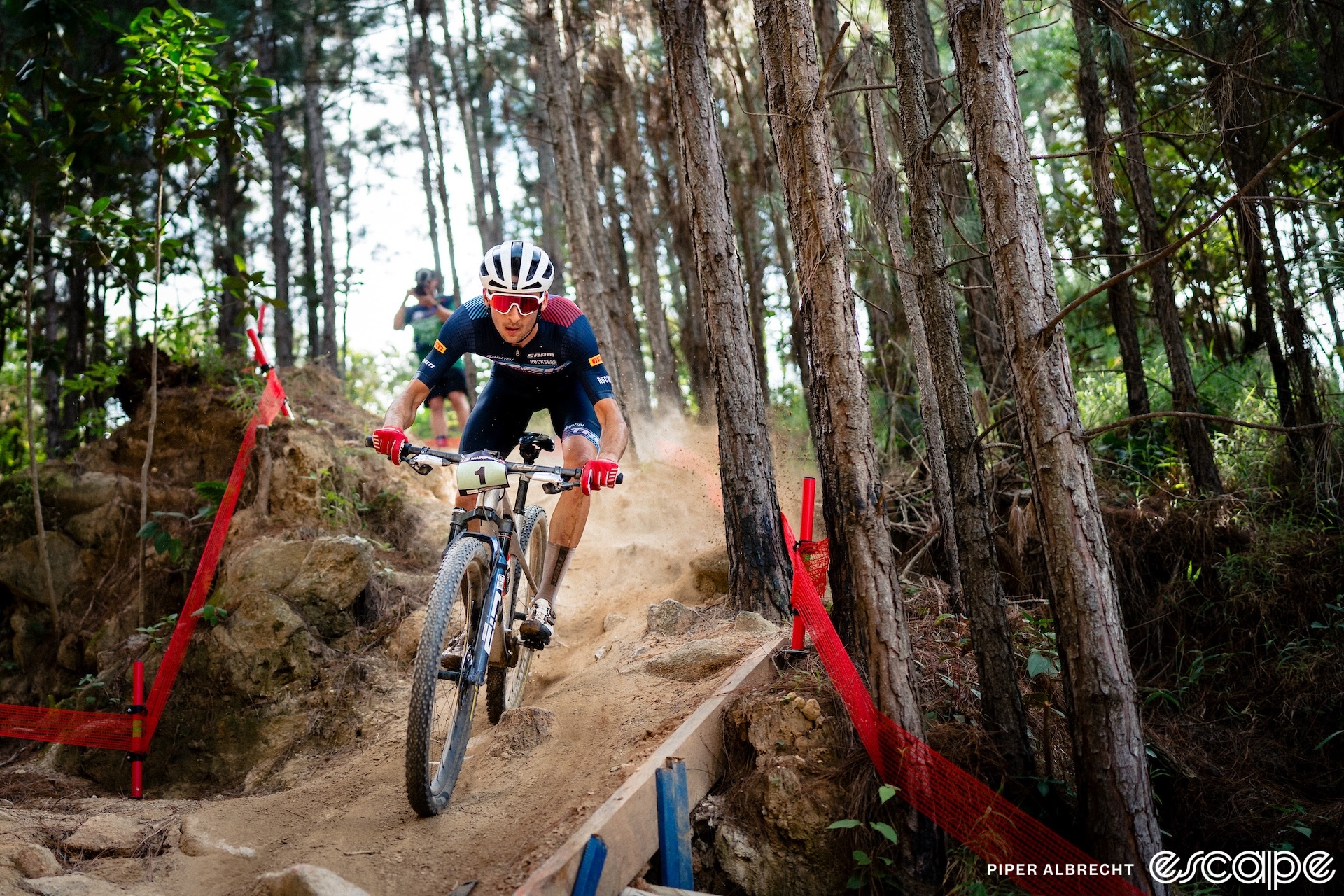
Amos had one last hurdle to overcome, however, as a nasty stomach bug knocked him out of the Les Gets World Cup in late June. “He came straight home,” said Charlie. “He was worried, he was upset, he was mad. He had no power. He’s a $500-a week-grocery bill and he was eating about a quarter of that. And he was upset because he just saw the days [to Paris] ticking down.
“Dude,” Charlie said to him, “You gotta figure this out.” The cure? Rest, some of mom’s cooking, and “getting some of that Durango water in him.” Before long, Amos began to bounce back.
While he opted to skip national championships, his gut finally calmed down and his training numbers shot back up, along with the grocery bill. But his last race was Crans-Montana, a month ago, so the form is a bit of a question mark. And, yeah, it’s the Olympics. “I don’t really know what it means to be part of the Olympics until I go there,” said Amos. “I don’t know the true weight of it.”
But even as he dials down the pressure, the competitor comes through. “I’m going to go and put up the best ride I can, obviously,” he said. He’s not going to the opening ceremony; race day is a little over 48 hours later, and the team hotel is an hour outside of Paris; late nights aren’t ideal preparation. He won’t say it himself, but a top-10 finish is absolutely possible.
Fun? Yeah, there’ll be time for that – afterward. “I’m going to stay a couple of days in the [athlete] village and see some events,” he said of his post-race plans. Rosaleen and Charlie, who’ve built vacations out of less-obvious European tourist destinations on the World Cup circuit, are coming over to watch, and they plan to do some sightseeing in Paris after the race. Violich is going too, with a busy schedule of events where her current and former athletes are competing.
But to be honest, Amos adds, as amazing as it will be to race in Paris, the Olympics aren’t his big goal for the season. That’s in late August, at the World Championships in Andorra. “This is the best opportunity I’ll ever get, with the race at altitude on a course I’ve won on,” he said. It’s his final year in U23, and he wants to go out on top.
Amos wants to be a top pro for a long time, to be one of the riders who returns American mountain biking to the pride of place it once had and can again. He knows that Los Angeles in four years may be his shot at a career-defining Olympic medal. But he also knows there are no guarantees that day will come. If it does, he’ll be ready. But he’s not waiting.
What did you think of this story?
